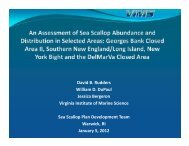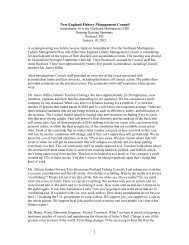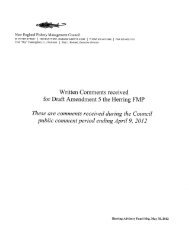Correspondence/Amendment 5 Comments - New England Fishery ...
Correspondence/Amendment 5 Comments - New England Fishery ...
Correspondence/Amendment 5 Comments - New England Fishery ...
You also want an ePaper? Increase the reach of your titles
YUMPU automatically turns print PDFs into web optimized ePapers that Google loves.
Z<br />
ãt<br />
ri':t:il<br />
Role of egg predation by haddock in the decline<br />
of an Atlantic herring population<br />
David E. Richardson"'1, Jonathan A. Hare", Michaet J. Fogartyb, and Jason S. Linkb<br />
"National Marine Fisheries Serv¡ce, Nât¡onal Oceanic and Atmospheric Administrat¡on, Narragansett, Rl 02882; and bNational Marine Fisheries Service,<br />
Nat¡onal Oceanic and Atmospheric Admin¡stration, Woods Hole, MA 02543<br />
Edited by John Beddington, lmperial College London, London, United Kingdom, and accepted by the Editor¡al Board July 5, 201 1 (received for review October<br />
13,2010)<br />
Theoretical studies suggest that the abrupt and substantial<br />
changes ¡n the productivity of some lisheries species may be<br />
explained by predation-driven alternate stable states in their<br />
population levels. With this hypothesis, an increase in lishing or<br />
a natural perturbat¡on can drive a population from an upper to<br />
a lower stable-equilibrium population level. After flshing is reduced<br />
or the perturbation ended, this low population level can<br />
persist due to the regulatory effect of the predator. Although<br />
established in theoretical studies, there is limited empirical support<br />
for predation-driven alternate stable states in exploited marine<br />
fish populations. We present evidence that egg predation by<br />
haddock (Melanogrammus aeglefrnusl can cause alternate stable<br />
population levels in Georges Bank Atlantic herring (Clupea harengus).<br />
Egg predation by haddock explains a substantial decoupling<br />
of herring spawning stock biomass (an index of egg production)<br />
from observed larval herring abundance (an index of egg hatching),<br />
Estimated egg survival rates ranged irom 98Vo. Overfrshing was clearly a primary driver behind the collapse<br />
of these populations. However, the magnitude of the<br />
population declines and, in some cases, the substantial delay in<br />
recovery suggest that another mechanism was involved in these<br />
population collapses. Part of the difficulty in identifing this<br />
additional mechanism stems from the complexity of the herring<br />
life cycle. Herring are migratory as juveniles and adults and<br />
planktonic as larvae. Herring populations tend to be made up of<br />
numerous subpopulations that mix during most of the year but<br />
have discrete spawning locations (15, 16). At these spawning<br />
Author contributions: D.E.R., J.A.H., M.J.F., and J.S.L. designed research; D.E.R., J.A.H.. and<br />
J.5.1. performed reseârch; D.E.R. and J.5.1. analyzed data; and D.E.R. ând J.A.H. wrote the<br />
papef.<br />
The authors declâre no contl¡ct of interest.<br />
Th¡s article is â PNAS Direct Submiss¡on. J.B. is ä guest ed¡tor invited by the Ed¡tor¡âl Board.<br />
1To whom correspondence should be addressed. E-ma¡l: dav¡d.richardson@noâa.gov.<br />
Th¡s art¡cle contå¡ns supporting ¡nformatìon online at w.pnas.org.¿læku/suppl/doi:10.<br />
1 073/pnâs.1 01 5400'l 081/-/DCSupplemental.<br />
PNAS Early Edit¡on I 1 of 6<br />
g<br />
c 3







